Haier HBF05E User Manual
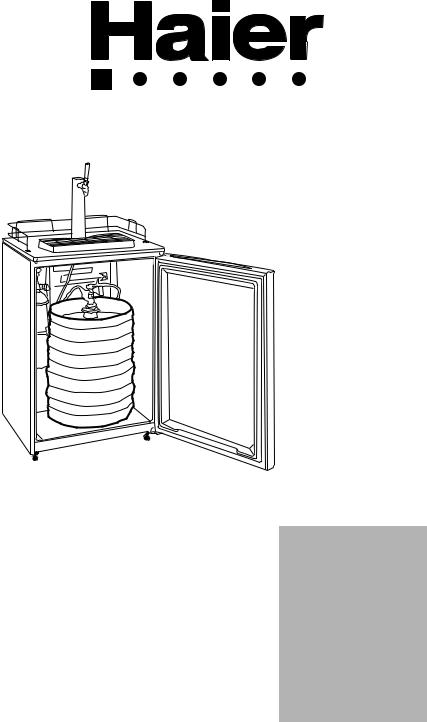
®
What The World Comes Home To TM
Beer Dispenser
BrewMaster
Fontaine à Bière
BrewMaster
Dispenser
De Cerveza
BrewMaster
Installation Instructions-
Model #
Instruction d'installation-
Modèle # HBF05E
Intrucciones De Instalacion-
Modelo #

English
SAFETY PRECAUTIONS
Read all of the instructions before using this appliance. When using this appliance, always exercise basic safety precautions, including the following:
1.Use this appliance only for its intended purpose as described in this operation manual.
2.This appliance must be properly installed in accordance with the installation instructions before it is used. See the installation section for more details.
3.This appliance must be connected to a proper electrical outlet with the correct electrical supply.
4.Proper grounding must be ensured to reduce the risk of shock and fire. Do not cut or remove the grounding plug! If you do not have a three-prong electric receptacle outlet in the wall, have a certified electrician install the proper outlet. The wall receptacle must be properly grounded.
5.Never unplug your appliance by pulling on the power cord. Always grasp the plug firmly and pull straight out from the outlet.
6.Immediately replace worn power cords, loose plugs and power outlets.
7.To reduce the risk of electric shock or fire, do not use extension cords or adapters to connect the unit to an electrical power source.
8.Unplug your appliance before cleaning or making any repairs.
9.We suggest that a certified technician perform the service if for any reason this product requires service.
10.If your old appliance is being discarded, we recommend that you remove the door and leave the shelves in place. This will reduce the possibility of danger to children.
11.This appliance should not be recessed or built into an enclosed cabinet. It is designed for freestanding installation only.
12.Do not operate your appliance in the presence of explosive fumes.
13.Do not tamper with the controls.
14.Do not operate this appliance unless all enclosure panels are properly in place.
15.Do not operate this appliance when parts are missing or broken.
16.Do not use this appliance for commercial use.
17.This appliance is designed for indoor use only and should not be used outdoors.
18.To reduce the risk of injury, do not allow children to play in or on the appliance. Close supervision is necessary when the appliance is used near children.
19.The appliance door must be closed during operation. Do not leave the door open when children are near the dispenser.
1
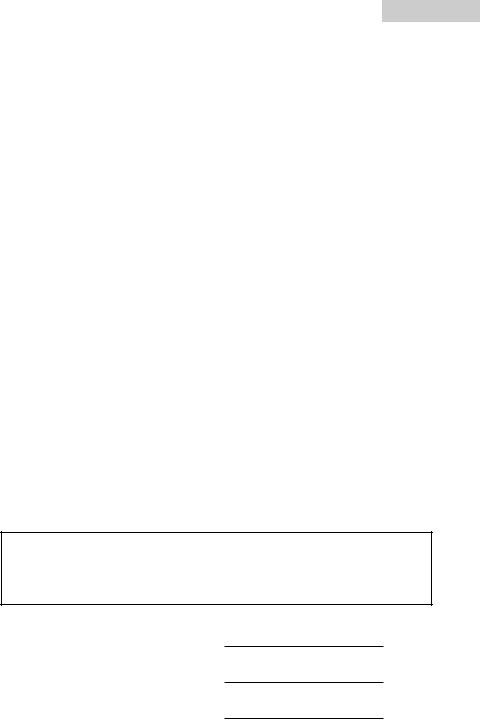
English
Important Safety Precautions of CO2 (Carbon Dioxide) Gas
1.CO2 gas can be dangerous! CO2 cylinders contain high-pressure compressed gas, which can be hazardous if not handled properly. Make sure you read and understand all the procedures for the CO2 cylinders before installation.
2.Always connect the CO2 cylinder to a regulator! Failure to do so may cause an explosion resulting in possible death or injury when the cylinder valve is opened.
3.Never connect the CO2 cylinder directly to the product container.
4.Always follow the correct procedures when changing cylinders.
5.Never drop or throw a CO2 cylinder.
6.Always keep CO2 cylinders away from heat. Store extra cylinders in a cool place (preferably 70˚ F). Securely fasten with a chain in an upright position when storing.
7.Always ventilate and leave the area immediately if CO2 leakage has occurred!
8.Always check the D.O.T. (Department of Transport) test date on the cylinder neck before installation. If it has been over 5 years, do not use. Return the cylinder to your gas supplier.
9.Never connect a product container unless there are at least two safety devices in the pressure system; one on the CO2 regulator and the other on the product container or in the pressure gas line.
SAVE THESE INSTRUCTIONS
For Future Use
DANGER!
Risk of child entrapment! Before throwing away your old appliance, remove the door so that children may not easily become trapped inside.
Thank you for purchasing our Haier product. This easy-to-use manual will guide you in getting the best use of your beer dispenser.
Remember to record the model and serial number. They are on a label in back of the unit.
Model number
Serial number
Date of purchase
2

English |
|
Table of Contents |
|
|
PAGE |
SAFETY PRECAUTIONS........................................................................ |
1-2 |
General Safety ............................................................................................ |
1 |
CO2 (Carbon Dioxide) Gas Safety ................................................................ |
2 |
UNPACKING AND ACCESSORIES INVENTORY .................................. |
4 |
PARTS AND FEATURES ............................................................................ |
5 |
PROPER LOCATION ................................................................................ |
6 |
ASSEMBLY INSTRUCTIONS .............................................................. |
7-10 |
Installing the Casters .................................................................................... |
7 |
Installing the Beer Tap .................................................................................. |
7 |
Installing the Guardrail.................................................................................. |
8 |
Installing the CO2 Regulator and CO2 Cylinder .............................................. |
8 |
Tapping the Beer Keg (Single-Valve Type Barrel) ............................................ |
9 |
Important Safety Message for Draft Beer Dispensing .................................... |
10 |
OPERATING YOUR BEER DISPENSER .......................................... |
10-12 |
Dispensing the Beer .................................................................................... |
11 |
Understanding Beer Temperature ................................................................ |
11 |
Understanding the Temperature Control Setting ............................................ |
11 |
Automatic Defrosting .................................................................................. |
11 |
Normal Operating Sounds.......................................................................... |
12 |
BEER SERVING GUIDE .................................................................... |
12-13 |
Beer Serving Tips........................................................................................ |
12 |
What a 1/2-Keg of Beer Gives You ............................................................ |
12 |
Tips for Cleaning Beer Glasses .................................................................... |
13 |
2 Simple Tests for Cleaning Beer Glasses .................................................... |
13 |
CONVERTING THE BEER DISPENSER TO |
|
AN ALL-REFRIGERATOR APPLICATION ........................................ |
13-14 |
ENERGY SAVING TIPS .......................................................................... |
14 |
PROPER CARE AND CLEANING OF THE BEER DISPENSER........ |
15-16 |
Installing the Cleaning Kit............................................................................ |
15 |
Cleaning and General Maintenance ............................................................ |
16 |
TROUBLESHOOTING GUIDE .......................................................... |
17-21 |
WARRANTY............................................................................................ |
22 |
3

English
Unpacking and Accessories Inventory
1.Remove all packing materials. This includes the foam base and all adhesive tape holding the accessories both inside and outside. Slide out and remove the plastic or foam guard used to secure the compressor during shipping.
2.Inspect and remove any remaining packaging, tape or printed materials before turning on the beer dispenser.
Note: Allow the beer dispenser to stand in an upright position for 2 hours before turning on the power.
Check all supplied accessories in the carton to be sure that all pieces are present and in good condition. A checklist of accessories is listed below for your reference. If you find any accessories that are not in good condition or are missing, please contact our customer service department for assistance. Our Toll-Free number is 1-877-337-3639.
1 Beer Tap Including:
1 Gasket for the Beer Tap
1 Washer for Connection to the Keg Coupler
1 CO2 Regulator
1 CO2 Cylinder
1 Keg Coupler
1 Cleaning Kit
1 CO2 Air Line
2 Hose Clamps
1 CO2 Cylinder Retainer
1Guardrail
1Drip Tray
4Casters
1Wrench
4Large Phillips-Head Screws
8Small Phillips-Head Screws
2Retainer Fixing Screws
2 Wire Shelves
4 Support Pins
4
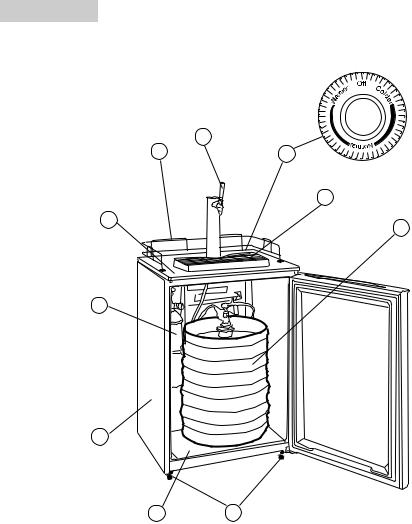
English
Parts and Features
7
6 |
8 |
9
5
10
2
1.Front Casters
2.Interior Keg Floor Support
3.Cabinet
4.CO2 Tank
5.Worktop
6.Chrome Guardrail
7.Chrome Beer Tap
8.Adjustable Thermostat (Located in rear.)
9.Drip Tray
10.Keg (Not included. Shown for illustration purposes only.)
5

English
Proper Location
•To ensure that your beer dispenser works at the maximum efficiency it was designed for, install it in a location where there is proper air circulation, plumbing and electrical connections.
•Choose a location where the beer dispenser will be away from heat and will not be exposed to direct sunlight.
•This beer dispenser is designed for indoor use only and should not be used outdoors.
•This beer dispenser is a freestanding design and should not be placed in a built-in or recessed area.
•The following dimensions are the recommended clearances around the beer dispenser.
Sides ........................ |
3/4" (19mm) |
Top .............................. |
1" (25mm) |
Back ............................ |
1" (25mm) |
6
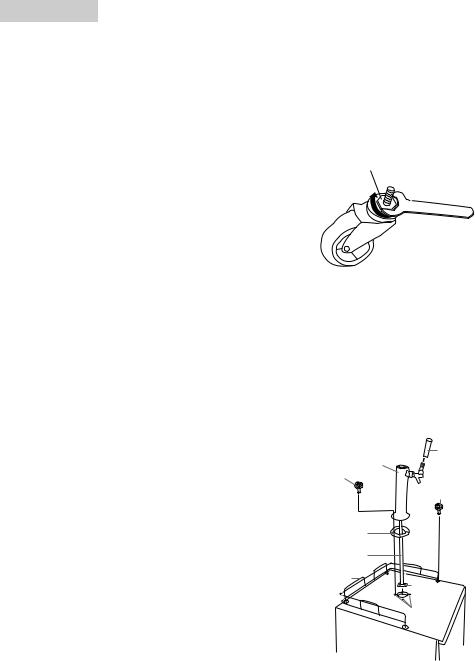
English
Assembly Instructions
Read carefully and understand all installation instructions before installing the beer dispenser. If after completing the process you are still unsure whether the beer dispenser has been properly installed, we recommend that you contact a qualified installer.
Installing the Casters |
Nut |
|
Follow the steps below to install the casters. |
||
|
||
1. Empty the inside of the cabinet completely and |
|
|
lay the beer dispenser down sideways. We |
Wrench |
|
recommend that you place a piece of |
||
|
||
cardboard or cloth underneath the cabinet to |
|
|
prevent dents or scratches to the cabinet. |
Caster |
|
|
2.Insert the casters into the holes on the bottom corners of the cabinet. Tighten each caster by turning the nut clockwise with the wrench provided.
3.Once all four casters have been tightened evenly, stand the cabinet in an upright position.
Installing the Beer Tap
Follow the steps below to install the beer tap.
1.First, remove the cabinet plug located on the worktop. Firmly grasp the cabinet plug, twist and pull upward.
Handle
Draft Arm Assembly
Large Philip Head
Note: Store this plug in a safe place as it will be required when converting the beer dispenser into a refrigerator.
2.Place the gasket over the wing nut on the bottom of the beer tap.
3.Pass the beer tube through the gasket to the base of the beer tap.
4.Push both the wing nut and the beer duct through the hole in the worktop until the beer tap is resting on top of the cabinet.
Gasket
Beer duct
Guard Rail
Small Phillips Head
wing nut
pilot holes
5.Align the holes of the beer tap with the gasket and pilot holes on the worktop of cabinet.
6.Secure the beer tap to the cabinet by inserting four large Phillips-Head screws into the holes and tightening.
7
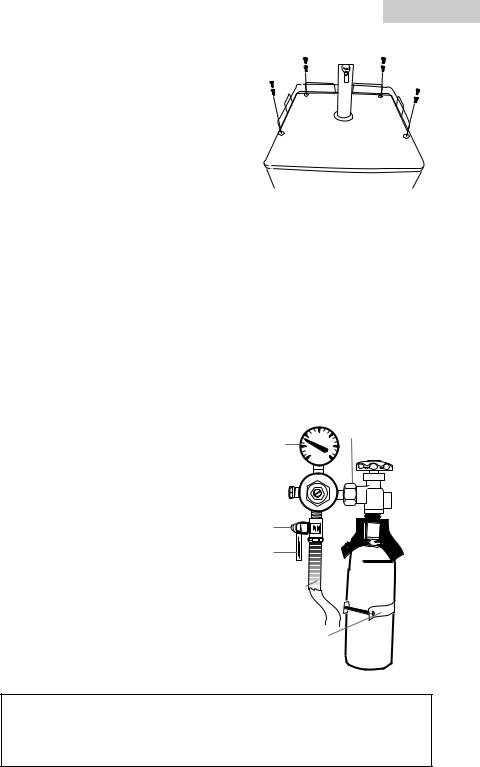
English
Installing the Guardrail
Follow the steps below to install the guardrail on the worktop.
1.Place the guardrail on top of the cabinet.
2.Align all holes of the guardrail with the holes of the cabinet.
3.Secure the guardrail to the cabinet with eight small Phillips-Head screws.
Installing the CO2 Regulator and CO2 Cylinder
Follow the steps below to safely install the CO2 regulator and CO2 cylinder. You must read and understand the following procedures for CO2 cylinders before installation.
Note: Your CO2 cylinder is shipped empty to avoid any possible accidents during transportation. When you purchase the first keg of beer, have your beer distributor fill the CO2 cylinder.
1.Install the CO2 air line hose to the regulator by attaching one end of the red air line hose to the hose barb connection on the
CO2 regulator. Secure the hose by using one
of the two self-locking black plastic snap-on clamps. Use pliers to snap the clamp on tightly to ensure that there are no leaks.
2.Attach the CO2 regulator to the CO2 cylinder by screwing the regulator nut onto the cylinder valve and tightening with an adjustable wrench.
3.Remove the nut from the retainer bolt.
Use two retainer fixing screws to secure the retainer to the holes on the back of the cylinder.
4.Slide the cylinder through the retainer and place it in the cabinet. Then tighten the retainer nut.
Connect to the CO2 Cylinder
CO 2
Regulator
Clamp
CO2 Cylinder
Shut-Off
Valve
CO2
Connect to the CO 2
Air Line
G
A
S
Retainer
WARNING!
CO2 can be dangerous! CO2 cylinders contain high-pressured gas, which can be hazardous if handled improperly. They must be handled with care.
8

English
Tapping the Beer Keg
(Single-Valve Type Barrel)
Your beer dispenser comes with an American Sankey Tap made by the Banner Equipment Company. This brand name is the most widely used in the United States. Before purchasing a keg, check with your beer distributor to make sure that a Sankey Tap can be used.
Note: For European draft beer, a European Sankey is required. Please call the Banner Equipment Company Toll-Free at (800) 621-4625 for more information.
Follow the steps below to tap the keg of beer.
1.Make sure the black pull handle of the keg coupler is in the closed (up) position before installing it on the beer keg. Insert the keg coupler into the locking neck of the beer keg and turn clockwise 1/4-turn to lock it into position. (see fig. 1)
Black pull handle (upward)
Connect to the Beer Line Hose
Connect to the CO2
Air Line Hose
fig. 1 |
Keg Coupler |
2.Attach the open end of the red air line hose to the hose barb connection on the keg coupler. Next, secure the hose by using the remaining self-locking plastic snap-on clamp to ensure that there are no leaks. Secure the clamp tightly with pliers.
(see fig. 2)
3.It is very important that the black rubber washer be installed inside the wing nut before connecting the beer line to the keg coupler. Remove the black rubber protective cap located on top of the keg coupler and screw the wing nut with the rubber washer onto the keg coupler. Hand-tighten firmly. (see fig. 3)
4.Make sure the beer tower faucet is in the closed (faucet handle pointing straight back) position before connecting the keg coupler and the beer keg. To secure the tank connection, pull the keg coupler handle out and push down until it locks into position. Listen for the "click" of the pull handle when it shifts into the final downward position.(see fig. 4)
T
|
|
KW |
|
C |
|
O |
|
|
L |
|
|
C |
|
|
N |
|
|
R |
|
|
U |
|
|
ISE
fig. 2
fig. 3
fig. 4
9
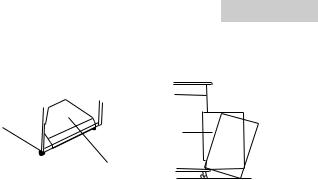
English
5.Carefully tilt the beer keg and rest the edge on the stainless steel keg floor support on the bottom of the interior cabinet. Slide the beer keg in slowly, ensuring that it is properly located.(see fig. 5)
Lift Upright
Beer Keg
fig. 5 |
Keg Support |
Important Safety Message for Draft Beer Dispensing
If CO2 is used for draft beer dispensing, the system must be adequately protected against excessive pressure build-up. This can be accomplished by installing at least two safety devices with adequate relief capacity in the system.
Safety devices should be installed in the following places:
A.On or immediately downstream from the CO2 regulator.
B.On the tapping device itself.
C.In-line in the pressure system.
Note: Locations A and B noted above are preferable. If possible, they should be built into the CO2 regulator and tapping device so that they cannot be removed or by-passed.
Operating Your Beer Dispenser
Dispensing Beer
Follow the steps below to dispense beer.
1.Make sure that the beer dispenser is plugged in properly to a 120V, 60Hz, 15Amp grounded AC outlet.
2.Place the drip tray under the beer faucet.
3.Open the beer faucet by pulling the tap towards you quickly and completely to dispense the beer.
Note: If for any reason the beer does not come out of the tap, refer to the trouble-shooting guide on page 17.
4.Increase the pressure if the beer runs too slowly. At the correct pressure and temperature, a 10oz. glass should be filled in 4 seconds.
5.Hold the glass steady at a 45˚ angle. When it is 2/3 full, start straightening the glass. Proper foam should be a tight creamy head and the collar on an average glass should be 3/4" to 1" high.
Note: It is normal to see condensation forming on the outer surface of the faucet. It
is caused by the difference in temperature between the cold beer and the |
|
inner surfaces of the faucet when beer is flowing through the line. |
10 |
|

English
Understanding Beer Temperature
•The recommended temperature for serving chilled beer is between 34˚ and 38˚F. To maintain this temperature in average room conditions of 70˚F, set the thermostat to "Normal."
Note: During the summertime when temperatures are warmer, we recommend that you adjust the control to a cooler setting accordingly.
•Select and maintain the proper temperature inside the refrigerator cabinet. This is necessary for maintaining the flavor freshness of beer.
•The best temperature for storing a keg is between 38˚ and 40˚F.
•Excessively cold or warm temperatures inside the refrigerator cabinet may cause a loss of flavor.
Note: Sour beer is produced as a result of secondary fermentation above 45˚F.
Understanding the Temperature Control Setting
The temperature control is located at the rear of the unit on the bottom left-hand corner. After turning the unit on, you must wait 24 hours for the unit to cool properly. You may then adjust the temperature setting based on your needs and preferences.
Automatic Defrosting
It is not neccessary to defrost the beer dispenser/refrigerator. Ice that has deposited on the evaporator is automatically defrosted when the compressor cycles off. The defrosted water collects in the water collection tray at the rear of the unit and evaporates.
11

English
Understanding Normal Operating Sounds
•Bubbling or gurgling sounds and slight vibrations are the result of the refrigerant circulating through the cooling coils.
•Sizzling or popping sounds occur during the automatic defrost cycle.
•Dripping sounds occur as ice melts from the evaporator and flows into the water collection tray during the automatic defrost cycle.
•Cracking or popping sounds are caused by the expanding and/or contracting of the cooling coils during the automatic defrost cycle.
Beer Serving Guide
Beer Serving Tips
The following tips will help you serve the perfect beer.
To serve beer from the tap the way it left the vat, check for the following:
• Cleanliness |
• Temperature |
• Pressure |
• Use CO2 whenever possible |
What a 1/2-Keg of Beer Gives You
This beer dispenser can hold up to a 1/2-keg. For your convenience, the following table shows how many servings a 1/2-keg provides.
No. of Glasses |
Glass Size |
|
|
|
192 |
12 oz. |
1/2-Keg |
= 15-1/2 Gallons |
|
236 |
10 oz. |
|||
|
= 1984 Fluid Ounces |
|||
264 |
9 oz. |
|
||
|
|
|||
290 |
8 oz. |
1/2-Keg |
= 6-3/4 Cases of 12 ounce Bottles |
|
353 |
7 oz. |
|
|
|
417 |
6 oz. |
|
|
12

English
Tips for Cleaning Beer Glasses
For the freshest flavor, it is important to serve beer in clean glasses. For your convenience, the following tips explain how to properly clean beer glasses before serving beer.
•Do not wash beer glasses together with glasses that have contained milk or any other fatty substance.
•An excessive amount of germicide build-up will also leave a fatty film on the glasses, which may cause flat beer.
•Wash glasses thoroughly with a good detergent to remove all fatty substances (i.e. lipstick).
•Do not use soap.
•Do not wipe glasses dry. Allow glasses to air-dry by placing them on a wire rack or on corrugated metal.
•Rinse in fresh cold water just before serving beer. It is best to serve beer in a wet glass.
Two Simple Tests for Clean Beer Glasses
1.Wash the glasses using your usual method. Immerse the glass heel first in clean water. Empty the glass. If water droplets cling to the glass or if spots appear on the glass while pouring, the glass has not been cleaned properly. A clean glass should air-dry crystal clear.
2.Again, wash the glass using your usual method. Pour out the water and then shake salt into the wet glass. If salt does not cling to the entire inside wall of the glass and clear unsalted spots remain, the glass is not clean.
Converting the Beer Dispenser to an All-Refrigerator Application
For your convenience, this beer dispenser can be converted to an all-refrigerator application. Simply follow the steps below for a quick and easy conversion.
Note: When using as a refrigerator, we do not recommend the use of casters, as stored items may fall off the shelves when the unit is in motion.
1.Close the main valve on the CO2 cylinder.
2.Close the connection between the beer keg and the keg coupler by pulling and lifting the handle of the keg coupler into an upright position.
3.Disconnect both the beer line and the CO2 air line from the keg coupler.
4.Remove the beer keg from the cabinet.
13

English
5.Disconnect the air line from the CO2 cylinder.
6.Remove the CO2 cylinder from the cabinet.
7.Remove the beer tower from the cabinet by grasping the center of the tower. Turn counterclockwise and lift.
8.Pull the beer line through the top of the cabinet.
9.Install the cabinet plug on the worktop.
10.Lay the unit down sideways. We recommend that you place a piece of cardboard or cloth underneath the cabinet to avoid dents or scratches to the cabinet. Remove the casters and install leveling legs.
11.Install the two wire shelves.
A.Insert one end of each support pin into the holes on the right side of the cabinet.
B.Place one end of the wire shelf into the left side of the cabinet and rest the other end onto the exposed support pins on the right side.
C.Repeat the same with the second shelf.
12.The conversion process is now complete. Store all the removed accessories in a safe place for future use.
13.Adjust the temperature of the unit as required for food storage.
Energy Saving Tips
Follow the energy-saving tips below for optimum efficiency.
•Limit the opening and closing of the door on hot and humid days. When you open the door, close it quickly to prevent hot air from entering.
•Check regularly for proper air circulation around the unit to make sure that the unit receives sufficient airflow.
•Keep the door gasket clean and pliable to ensure a proper seal. If the door gasket is not sealed properly, hot air may easily enter into the unit, making the interior temperature warmer. The compressor must then run continuously to keep the unit cool, thus making the energy consumption very high and inefficient.
Note: Replace a damaged door gasket to restore energy efficiency.
• DO NOT store hot food in the unit. Let the food cool before refrigerating it.
14

English
Proper Care and Cleaning of the Beer
Dispenser
Installing the Cleaning Kit
Read and understand the following instructions before installing the cleaning kit.
1.Mix one gallon of warm water and one ounce (one tablespoon) of cleaner in a bucket.
Note: Do not use lye, soap or hot water.
2.Remove the cleaner cap. Fill the jar and replace the cap. Leave the remaining solution in the bucket.
3. Turn off either the air cock on the regulator or the valve on the CO2 tank.
4.Disconnect the tap from the barrel. Then disconnect the beer line from the tap by turning the nut counter-clockwise. Place the tap and the end of the hose in the bucket.
5.Remove the faucet from the tower with the wrench and attach the fitting on the cleaning bottle in its place.
Note: Make sure there is a washer in the back of the fitting.
6.Hold the cleaning jar upside down until the solution runs through to the bucket as shown in the above figure.
7.Fill the jar with cool clean water and repeat the process until the water runs clear.
8.Rinse the tap in the bucket with cool water.
9.Remove the fitting from the tower and replace the faucet. Make sure the washer is in the back of the faucet.
10.Re-attach the beer hose to the tap and attach the tap to the barrel.
Note: Beer lines should be flushed after each keg is emptied.
15
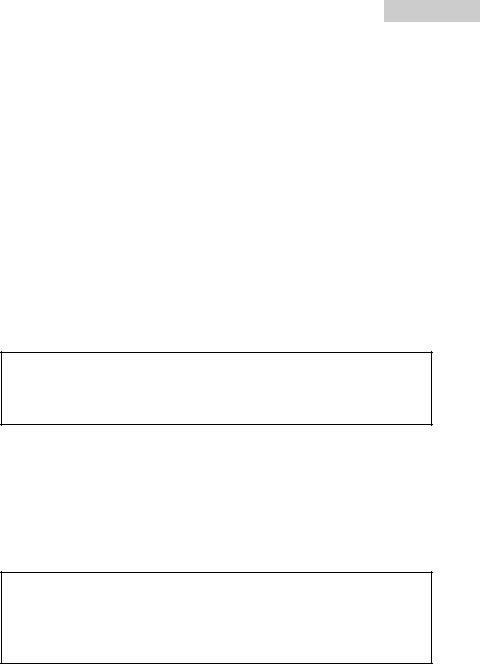
English
Cleaning and General Maintenance
General Interior and Exterior Cabinet Cleaning
1.Prepare a cleaning solution of 3-4 tablespoons of baking soda mixed with warm water. Use a sponge or soft cloth dampened with the cleaning solution to wipe down the interior and exterior surfaces of the cabinet.
2.Rinse with clean, warm water and dry with a soft cloth.
Note: Do not use harsh chemicals, abrasives, ammonia, chlorine bleach, concentrated detergents, solvents or metal scouring pads. Some of these products may dissolve, damage and/or discolor the cabinet finish.
Door Gasket Cleaning
1.Clean the door gasket with a damp cloth every three months. The gasket must be kept clean and pliable to ensure a proper seal.
2.Petroleum jelly applied lightly to the hinge side of the gaskets will keep the gasket pliable and ensure a good seal.
WARNING!
To avoid electric shock, always unplug your beer dispenser before cleaning. Failure to do so may result in possible death or injury.
Cleaning Behind the Beer Dispenser
1.We recommend that you clean the rear of the refrigerator at least twice a year.
Note: Some operating environments may require more frequent cleaning.
2.Use a vacuum or a brush to clean the coils.
CAUTION!
Before using cleaning products, always read and follow the manufacturer’s instructions and warnings to avoid personal injury and product damage.
16

English
Troubleshooting Guide
When dispensing beer into the glass, if you find that the beer is Cloudy, Flat, Bubbly, Off-Taste, Sour, Wild or Tail-End Beer, refer to some of the following hints.
Beer Condition: Cloudy Beer
The beer in the glass appears hazy, and not clear.
Cause 1
Excessively low temperatures may cause hazy or cloudy beer, particularly when the beer lies in the cold coil for long periods of time.
Correction
•Make certain that the lines are thoroughly cleaned and then raise the temperature slightly.
Cause 2
The beer faucet was only opened partially.
Correction
•Open the faucet quickly and completely.
•Replace any worn washers and parts in the faucet when necessary to allow the faucet to be fully opened.
Beer Condition: Flat Beer
Beer lacks its usual brewery-fresh flavor. The foamy head disappears quickly.
Cause 1
The glass is greasy.
Correction
•Do not wash beer glasses together with glasses that have contained milk or any other fatty substance. An excessive amount of germicide build-up may also leave a fatty film, which will cause beer to go flat.
•It is preferable to steam and sterilize glasses where health laws permit.
•Wash glasses thoroughly with a good detergent to remove all fatty substances (i.e. lipstick).
•Do not use soap.
•Do not wipe the glasses dry. Permit glasses to air-dry by placing them on a wire rack or on corrugated metal.
•Rinse the glasses in fresh cold water just before serving beer. It is best to serve beer in a wet glass.
17

English
Cause 2
Improper drawing of beer into the glass.
Correction
•Open the faucet quickly and completely.
•Proper foam should be a tight creamy head. The collar on the average glass should be 3/4" to 1" high. Beer drawn without head has the appearance of being flat.
Cause 3
Not enough pressure.
Correction
•Increase the pressure if beer runs too slowly. The correct flow should fill a 10oz. glass in 4 seconds. (Approx. 8oz. of liquid)
•Check the pressure source to determine whether there are obstructions in the air line.
•Replace a sluggish air source or the CO2 regulator and gauge.
•The tank pressure must always be higher than the pressure used on the keg.
•Always apply pressure to the keg before drawing beer.
Beer Condition: Loose Foam
Large soap-like bubbles that settle quickly.
Cause 1
This is generally the same as the Flat Beer condition. See the Flat Beer causes above.
Beer Condition: Off-Taste Beer
Often bitter and bitey; sometimes completely lacking in flavor and zest. May also have an oily or foul odor, which carries an unpleasant taste.
Cause 1
Improper cleaning of the tap.
Correction
•Brush and clean the tap properly. It should be scoured using a detergent, then rinsed clean.
Cause 2
Contaminated air line.
Correction
• Air line should be examined. If contaminated, it should be replaced.
18

English
Cause 3
Improper type of air line
Correction
•A rubber hose will absorb and retain odors. Try using a plastic or copper hose instead.
General Recommendations for Off-Taste Beer:
Beer lines should be flushed after each keg is emptied. Maintain fresh, clean, sanitary conditions around the dispenser. Smoke, cooking odors and disinfectants will harm the taste and flavor of beer. These conditions, as described, may come from an air source or from actual contact with the glass when drawing beer.
Beer Condition: Sour Beer
Beer tastes and smells extremely yeasty or moldy.
Cause 1
Improper transporting of beer kegs. Beer that is delivered on an open truck during high summer temperatures may start a secondary fermentation process.
Correction
•If possible, have beer kegs delivered in a closed, refrigerated truck. If an open truck is used, cover beer kegs with tarpaulin for protection against summer heat and warm air.
Beer Condition: Wild Beer
Beer that is either all foam, or too much foam and not enough liquid.
Cause 1
Improper drawing of beer into the glass.
Correction
•Open the faucet quickly and completely.
•Proper foam should be a tight, creamy head, and the collar on the average glass should be 3/4" to 1" high.
Cause 2
Yeast growth or other obstructions in the faucet, which is usually caused by a non-refrigerated faucet. Worn faucet parts and worn faucet washers.
Correction
•Check for, and replace any kinked, dented, or twisted lines from the barrel to the faucet.
•Examine for frayed coupling washers behind the faucet that may cause an obstruction.
19

English
Cause 3
The beer was stored in an area that is not cold enough and has thus become warm.
Correction
• Keep kegs of beer refrigerated at all times at 40°F all year round!
Cause 4
Too much air pressure.
Correction
•First, check the source of pressure to make sure it is working. Then adjust the pressure to suit a properly balanced system. The correct beer flow should fill a 10oz. glass in 4 seconds at the proper temperature.
Cause 5
Excessive amounts of CO2.
Correction
•Adjust the CO2 pressure to as low as possible. However, the applied pressure must remain slightly higher than the internal pressure of the beer. No more than 18 lbs. should be applied. The proper amount should be between 10-12psi/lbs.
•The colder the beer and the higher the applied CO2 pressure, the more rapid the absorption of CO2 by the beer. This over-carbonates the beer, causing Wild Beer.
•Check the pressure regulators periodically to ensure that the operating pressures remain constant.
Cause 6
Not enough pressure or no pressure at all.
Correction
•Check for defective air vents.
•Always turn the pressure on before drawing beer.
Cause 7
An old keg of beer which has not been stored in cool temperatures has been used.
Correction
•If beer has been allowed to stand in warm temperatures beyond 45°F for an excessive length of time, it may begin a secondary fermentation. Store beer at 40°F all year round.
20

English
Beer Condition: Tail-End Beer
Beer draws well at the beginning of the keg. Towards the bottom, it becomes flat. This is more likely to occur when beer turnover is slow.
Cause 1
Where air is used as a pressure source, air replaces the CO2 in beer, causing flat beer. This problem is not evident when beer is being drawn rapidly.
Correction
• Whenever possible, use CO2 Gas as a pressure source.
21
